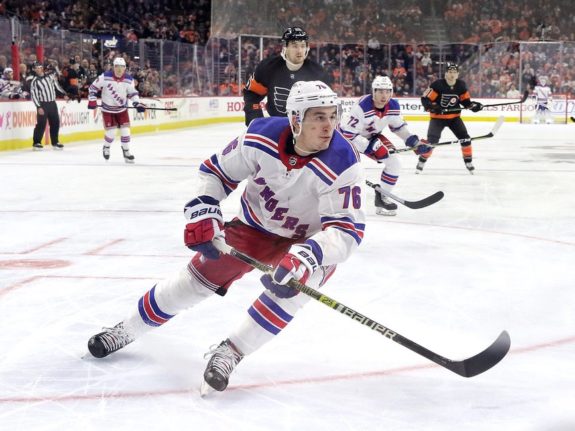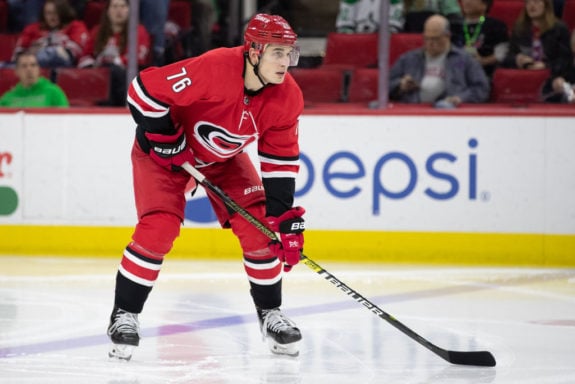Now that the Seattle Kraken Expansion Draft is in the rearview mirror, the Carolina Hurricanes are faced filling the hole that was left in their lineup after the Kraken selected Morgan Geekie, which was unexpected. The biggest debate heading into the draft was whether the ‘Canes should protect the more promising, younger defenseman Jake Bean or the steady, top-four veteran Brady Skjei. The team chose the latter, and I was on board with the decision.
During the 2020-21 season, I went from being a Skjei detractor to a believer. I watched him became more comfortable with the team’s defensive system and emerge as a key component of the blue line. He would’ve been a difficult player to replace if he had been lost to Seattle. For many reasons, the ‘Canes made the right choice by committing to Skjei.
Growing In The System
I understand why fans can be tough on Skjei. His stride is awkward, and when he has the occasional lapse in concentration with the puck, it ends up in the back of the net. He’s not the sharpest puck handler, he’s not a truly skilled or flashy player, and he doesn’t play on the power play. That’s why I was skeptical when the Hurricanes traded a first-round pick for him in Feb. 2020, but not anymore.
What really impressed me last season was Skjei’s defensive play. His positioning in the defensive zone was sharp, and he was consistently effective with his stick checks. He’s more of a reactor than an anticipator – which is usually a recipe for disaster – but his gap control is solid, and he’s much more physical player than I was expecting, which makes up for his lack of high-level awareness.
Skjei isn’t an imposing physical presence, but at 6-foot-3 and 210 pounds, he’s not shy to throw his body around. He led all Hurricanes defensemen with 66 hits in 2020-21 and finished fourth on the team with 62 blocked shots. With Skjei on the ice, the ‘Canes controlled 52.3% of the shot attempts at even strength, despite that he started over 54% of his shifts in the defensive zone. Even with tougher assignments, he had favorable results at both ends of the ice. He may have been snake-bitten offensively, but he did a good job of getting pucks to the net and found the right spots in the offensive zone:
I spoke to Samantha Prevot (@s_prevot), who provides awesome coverage of the New York Rangers for Blue Seat Blogs, about the biggest differences she’s seen in Skjei’s play since his arrival in Carolina, and she was impressed by his development:
“I think his game is definitely becoming more well-rounded,” Prevot said. “His offensive game has always been strong, but now he’s learning when to pick those moments to pinch/jump into the offense, and when to be more stay at home and hang back. I think in general, Carolina’s system is more beneficial to his play style because he has freedom to do both.”
Samantha Prevot, @s_prevot.
She also attributed Skjei’s newfound success to playing in a smaller market in Carolina vs. the microscope he was under in a Rangers sweater where every mistake was apparent.
“I also think Skjei was a victim of super high expectations from Rangers fans because he was coming up at the end of their competitive window, [and towards] the beginning of their rebuild,” she said. “In Carolina, he can play a significant role, but still at the same time, he can just play his game and do his part.”

Everything Prevot alluded to was particularly noticeable in Skjei’s play last season, and by the time the playoffs rolled around, he was a real force on the blue line. After an injury to Jaccob Slavin, who missed Games 2, 3 and 4 in their first-round series against the Nashville Predators, Skjei stepped up. He was brilliant in Games 3 and 4 in Nashville, and, despite that the ‘Canes lost both in overtime, he played a major role with almost 40 minutes of ice-time per game, and he earned the respect of fans with his relentless effort and hard-nosed defending.
Key to the Penalty Kill
Skjei made his biggest impact on the penalty kill and was a major reason that the team finished with the third-best success rate in the NHL during the regular season, killing off 85.23% of their penalties. Throughout the season, he averaged 2:40 per game on the kill – only two seconds less per game than Slavin – and earned head coach Rod Brind’Amour’s trust.
His contributions on the penalty kill were vital to its success. In over 150 minutes of shorthanded time during the season, the Hurricanes surrendered 12 power-play goals when Skjei was on the ice. His suppression rate of 5.2 goals per 60 shorthanded minutes ranked second on the team behind Brett Pesce. His 15 blocked shots were also the most of any Hurricane on the penalty kill.

By all accounts, losing Skjei to the Kraken would have created a massive hole on the penalty kill. The team only has three defenders that they trust on that unit: Pesce, Slavin, and of course, Skjei. Haydn Fleury had strong analytical results with the group, but his ice time was inconsistent, and he was eventually traded to the Anaheim Ducks. Fleury’s replacement, Jani Hakanpää, couldn’t replicate his success despite being given a bigger role. Dougie Hamilton was also a regular (with 1:30 per game) but had the worst results of the bunch and may not be back with the team next season.
Suffice to say, the success of the penalty kill makes the decision to protect Skjei all the more important. Bean is on the roster – for now – but it’s unlikely that he’ll ever be a regular on the kill – while Skjei had some of the best results in the league. Management arguably needs to find a fourth defenseman that they trust on the penalty kill this offseason, but without Skjei, they would have had two holes to fill.
Win-Now Mode
The Hurricanes’ protected list – after you take away players that were considered “untouchables” like Slavin, Pesce, Sebastian Aho, Andrei Svechnikov and the other obvious ones – Skjei would’ve been arguably the toughest loss to replace for a team that’s entering their Stanley Cup window. Legitimate top-four defensemen don’t grow on trees, and he’s a player that the team’s coaching staff has learned to trust with top minutes and assignments.
The ‘Canes also have virtually zero internal options to replace Skjei. While Bean has some untapped upside that’s worth developing, his role in 2020-21 wasn’t big enough to be considered irreplaceable, especially considering Maxime Lajoie looked comfortable in his stead. Replacing a player like Skjei would be much more difficult considering his usage, and the organization doesn’t have any prospects who are ready to handle that type of role.

On the flip side, while losing Geekie is unfortunate, the ‘Canes have many young forwards who can step into his role, including Jack Drury, who’s coming off a fantastic development season in Sweden and who the Hurricanes signed to an entry-level contract earlier this month. He, along with several others, could be primed to make the jump to the NHL next season with a strong performance in training camp, which makes losing a bottom-six forward like Geekie a lot easier to navigate.
What all of this means is that committing to Skjei as part of the Hurricanes’ core group was the best way to keep the team competitive moving forward. Hamilton is on the verge of hitting unrestricted free agency, and he may have played his last game for Carolina. Bean is still uncooked, and his defensive game needs to grow before he earns a top-four role. Jake Gardiner’s health status is a mystery, and Hakanpää is also an unrestricted free agent – though he underwhelmed during his time in Raleigh.
Protecting Skjei was the correct choice. Heading into the offseason, the Hurricanes’ defense has more questions than answers, but Skjei provides stability. He’s proven his quality, he’s signed for another three years at a reasonable $5.25 million AAV, and the coaching staff trusts him. The team is entering their “Stanley Cup-or-bust” window, so retaining Skjei was a necessity, and they will benefit from the decision moving forward.